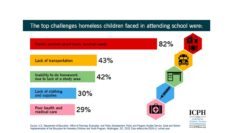In the United States, over half a million people experience some form of homelessness each day, with mothers and their children representing around a third of this number. The profound stigma faced by homeless mothers is rooted in social perceptions that they have made poor life choices, are selfish, and are unfit mothers. This blame intensifies when they are addicted to drugs or alcohol.
To investigate how women who recover from addiction experience mothering their children in a homeless shelter, we conducted a qualitative study that used interviews from six mothers who resided at a long-term homeless shelter in the mid-Southern US. We found five recurring themes that illustrate how institutional, political, historical, and economic contexts shape assumptions of “appropriate mothering:” 1) knowing your child; 2) mothering on shelter time; 3) mothering with restricted mobility; 4) mothering in absence; and 5) mothering other children. The constraints that existed for the women were prominent throughout all five themes.
The examples shared here come from interviews with two women, Charlene and Ellen. Concerning their living arrangements, the women described the physically restrictive environment in which they resided with their children. Charlene labeled her individual room in which she lived with her children a “little box.” In Ellen’s case, she explained, “[my son] and my parenting dynamics are completely different living here and living in a room than what they would be in a house of my own,” where rooms are more spacious and the two can take time for solitude. While strikingly better than inconsistent housing, a single room impacted how the women could interact with–and also get some time apart from–their children.
There is not one fixed way of mothering a child, particularly when a family is homeless and lives in a shelter.
The families’ daily schedules, too, were marked by restrictions that significantly influenced the ways the women engaged in mothering. The women discussed how most of their free hours were assigned to specific mandatory meetings and sessions for their addiction. This heavy focus on the women’s recovery interfered with basic mother-child activities, such as doing homework or playing together.
Charlene noted that their schedules were so packed with meetings that they would return to their rooms late at night and still need to work on school assignments with their children: “I had to help both my kids with their homework…So, I was just going back and forth. He was like, ‘Can you help me with this?’ ‘What is this?’ ‘Mama, what I got to do next?’ I was like, ‘Y’all wait a minute, slow down.’” Ellen also pointed out that the tight scheduling contributed to frustrations between her and her son: “I feel like I can’t let him have a bad day for that little bit of time I have for homework, and that’s not acceptable to me.” Ellen, like other residents, was striving to support her child on someone else’s schedule.
There is not one fixed way of mothering a child, particularly when a family is homeless and lives in a shelter. However, many mothers face others’ expectations of what successful and appropriate parenting should entail and much judgment when they parent outside the norm. This key finding from our study is echoed by other research. The presence of diverse and positive mothering is especially important in a population facing extreme challenges socially, economically, relationally, and in their health. In order to prevent homeless, poor, addicted, single, etc. mothers from becoming “cultural scapegoats” in our society we cannot measure mothering against idealized, unattainable standards. We all must engage with homeless families and interrogate our assumptions about child-rearing. This will better serve women recovering in shelters with their children and can be implemented through training of shelter staff, policy changes, and public conversations about families in crisis.
Increasing the opportunities for the women to step out of the parenting role can also be helpful. For example, in the shelter where we worked the director requested one of us lead a book club for the mothers, an engaging activity that did not center the women’s addiction recovery or their parental shortcomings. A weekly art class also provided time for the participants to step out of the labels of “addict,” “homeless,” even “mother” to reflect on their past, present, and future. Creative activities such as these allow the women’s voices to be heard using verbal and visual communication, and the mothers appreciated being included in the planning of art classes, evident from one of the women saying: “You really care what we think.”
Providers should, therefore, facilitate such interactive programs for the mothers and their children and provide ongoing opportunities for the women to take an active role in decision-making processes at the shelter. When staff and residents work together to create rules and policies, they all can learn how the experiences/resources/needs of families can be used to negotiate new norms and reset what is considered mothering in the margin.
Feature image: lstvan, Motherhood (detail), CC BY-NC-ND 2.0
















